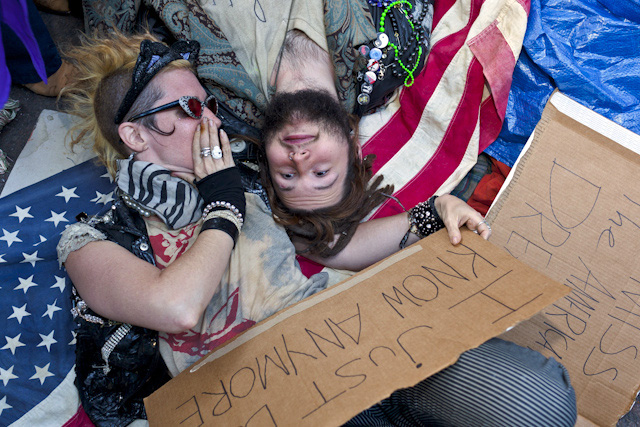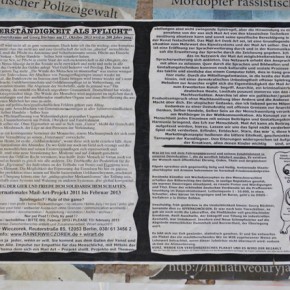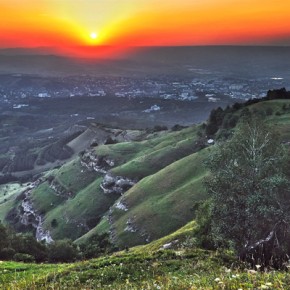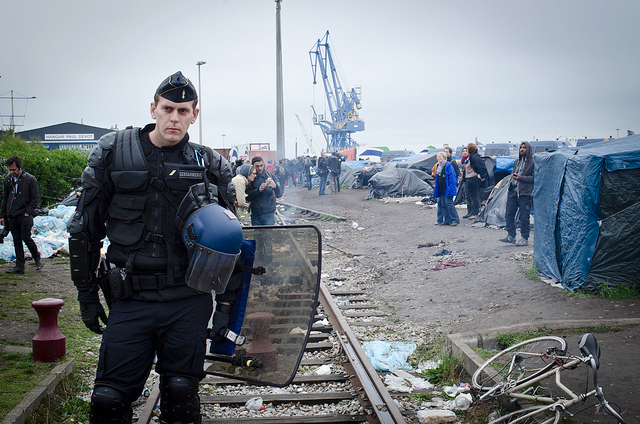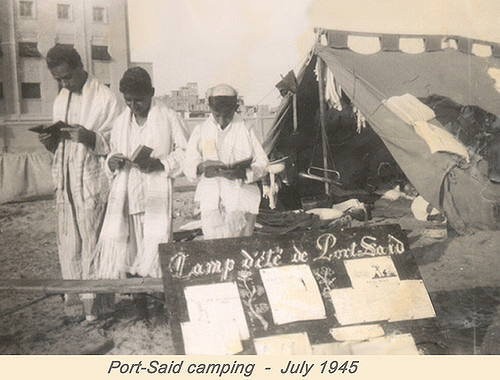Last week, the Humanities Center at Pittsburgh’s Carnegie Mellon University held a roundtable event on the origins of Occupy Wall Street. Commemorating the first anniversary of the uprising, the gathering could not have been more necessary, or appropriate.
The conference’s schedule included talks by Pittsburgh rapper/video artist Jasiri X; Bill Scott, one of the founders of the People’s Library at Zuccotti Park; and Dana Balicki, from the OWS PR team, together with scholars from CMU’s and the University of Pittsburgh’s English, modern languages and sociology departments offering a range of insights.
The programming was rich, and informative. However, as the event progressed certain gaps became apparent, perhaps due to my own research inclinations. [Disclosure: A lecturer (Assistant Professor) in Film Studies at the University of St Andrews in Scotland, I’m enjoying the hospitality and research support of the Humanities Center as their research fellow this year where their topic is “Media and Social Change”.] To wit, no media scholars were included in the roundtable. I found this especially difficult to digest given the importance of various media (screen media, social media, journalistic media) to contemporary protest politics in general, not just OWS. This may have been a result of the time limits imposed on the speakers, but given my preoccupations, these were foremost in my mind.
This is not to say that the topic of media wasn’t present. It was a component of many of the talks at the roundtable. It just could have been more specific and more historically minded. For that reason, I’d like to seize on those moments that could be pushed further and tease them out, to their logical conclusions. My reasons for doing so are fairly straightforward. It is important to be historically self-conscious of the use of media in modern protest movements. As recent events have illustrated, leveraging social media can aid in the mobilization of people around the world as they demonstrate against authoritarian regimes. However, the use of media in social change is nothing new, and there is a lot to be learned from the ways they have worked and the ways they haven’t.
Introducing the event, Kathleen Newman challenged the claim that Adbusters launched OWS, recalling the Bloombergville of 2011 that went largely unreported (save for by Adbusters.) Continuing, Newman noted acts of resistance, which predated OWS, including the Charging Bull, a bronze sculpture created by Arturo Di Modica as a symbol of strength and resilience following the 1987 crash. A guerrilla project of its own (even if pro-capitalist.), on 15 December 1989 Di Modica placed it underneath the Christmas Tree before the New York Stock Exchange as a gift. Initially removed and impounded, it was later restored to public space two blocks south of the Exchange. In 2010, Polish artist Agata Olek covered the bull with a crocheted sweater, ostensibly for those who could not afford coats. Not only could we see a legacy of occupations, but one of the resignification of public space and objects through artistic interventions. Through participation meanings and perspectives could change. Public space: The first frontier of interactive content.
Bill Scott’s discussion of “The People’s Library” called attention to smaller acts of information exchange. Beyond the production of a generous lending library in Zuccotti Park, his (and others’) careful documentation of the project helped to create its own archive. By chronicling the creation and the donations of reading materials, the librarians could account for the cost of the literature confiscated and destroyed by NYC authorities. Because of this activity, OWS can sue the city for destroying this property. Reading between the lines, we see the activist potential behind archival work and the labor of librarians. And we can start to think about the relationship between media and politics without rushing to think only of new media and without relying on the simplistic formulation of exposure leading to action—one that has amplified alongside the developments of mobile and digital technologies that have accelerated the means and reach of documentation and transmission.
I do not dispute the key role of digital and social media in mobilizing OWS. However, one grows weary of unquestioned claims such as “And social media made it all possible.” Rather than praising the importance of these utilities, we should be asking how movement communications translated so quickly into concrete and effective political activities. Twitter, for example, can’t start revolutions by itself. It has to have some content, which users create, project and respond to. What makes for an effective and affective cry to action? What kinds of uses best transform transmission into action?
Jasiri X mentioned that his earlier activist and video work yielded an invitation to participate in OWS and carried through into Occupy Pittsburgh and Occupy the Hood. In doing so, he necessarily pointed out the frustrations within the African American community that both predated and were echoed in OWS. One ought not to forget their historical contribution, he reminded, nor should one forget the differences as civil injustices remain a powerful concern alongside the social and economic ones. Occupy the Hood, then, is a necessary step in that direction. Maria Del Mar Rosa Rodriguez’s presentation on Los Indignados similarly examined the origins of OWS within Spain’s mass protests—which shared both concerns (social justice, corruption) and practices (demonstrations and encampments). And like X, she traced their forward movement as protesters decamped and moved into local communities to partner with established organizations. These activities may not be so visible, but they are crucial, and point to the successes and accomplishment of the Occupy movements so far.
It was frustrating that Dana Balicki could not overcome the vagueness of her repeated reference to “The Media” as a singular monolith. One can understand the practice, particularly in light of the troubling consolidation of media ownership that leads to a comparable consolidation of opinion, but without discussing this or the role of counter-reportage online through citizen journalists and the rising availability of online global news outlets like The Guardian, a rigorous consideration of journalistic media is absent. Had Balicki offered more specifics around the challenges of working with reporters or the ways in which the OWS PR team found social media to be useful, this could have been a fabulous contribution: How did the they package and spin the various events? How did they aim to present cohesion in this mass protest?

Alongside the presentation on Los Indignados, an informative talk on Arab Spring (by University of Pittsburgh sociologist Mohammed Bamyeh) continued to broaden the perspective beyond the U.S.—an essential contribution to critical thinking if ever there was one. Needless to say, this is a vast topic whose breadth and depth could not have been covered in the five minutes granted. So I take the opportunity here to further deepen the topic, not only in terms of media usage (a critical factor in the mass demonstrations and uprisings of 2011) but also in terms of history. It’s helpful to recognise that the mood that gave rise to OWS began before 17 September 2011, but when the subject of social media and populist protest come into play there is value in looking beyond the launch of the Arab Spring in Tunisia, December 2010.
Two areas of protest in particular came to mind:
First, Iran, past and present, loomed large for me here. Although Iran is by no means ‘Arab’, I couldn’t help but think about the 1979 revolution. This was a populist movement prior to the fundamentalist Islam that took over. And it was a revolution that relied on the uses of “small media”—leaflets, posters, audiocassettes and possibly ‘telephony’ in order to mobilise political publics. (Annabelle Sreberny and Ali Mohammadi discuss this in the excellent Small Media Big Revolution.) How thrilling it would be to trouble the digital fantasies that arise, as we find the roots of social media within small media, and explore the relationships as well as the divergences.
The Green Revolution may deserve thought as well. Although not exactly a ‘revolution’ in that no regime change occurred, this vast protest against the 2009 Iranian elections resulted in a violent government crackdown. The uses of Twitter and YouTube were crucial as modes of alternative communication and reportage in the face of a media blackout and the government’s shut down of SMS. [I wrote about this issue, albeit tangentially, in a review of The Green Wave for Souciant.] It also predated their employment by North African and Egyptian pro-democracy protestors during Arab Spring. The failure to generate immediate change by no means invalidates their use of social media. It would be hard to imagine subsequent revolutionary activity anywhere else afterwards in the world without it. In summer 2011, SMS, instant messaging and blasts on Twitter helped the protesting (or rioting) youth of London to coordinate their efforts, whether in planning offensives or evading authorities. These same media platforms also aided locals who wished to avoid conflagrations.
And there’s always more to learn. For example, Iranian ex-pats following the revolution online initially used Googlemaps to help direct protesters to safe spaces before they realized this was something the government could also monitor. Perhaps more well known is the story of Nedā Āġā Soltān, whose death—caught on video and circulated on YouTube – became an iconic rallying point for protest within the nation and beyond. At the same time, the fervor to use this woman and her image led to the mistaken use of the Facebook photograph of Nedā Soltāni. This misuse (and the viral spread facilitated by the online technologies that enable sharing with a quick click) resulted in an unwanted political identity and unwelcome attention from the government requiring the woman to seek asylum in Germany. Social media can make protest possible. They can also accomplish other things. If we are to think about the relationship between media and social change, it is helpful to dig deeply into such precedents.
Second, the economic and social protests of the nineties and the naughties were absent from the discussion. This was a panel geared to consider the origins of OWS—a mass demonstration in response to social and economic injustice—and the role of media in social change. Any yet, there should be no mention of the alter-globalization movement (called so to distinguish its openness to international relations, but not to the neoliberal form globalization had been taking). [A tip of the hat to Joss Hands who provides this distinction in the excellent @ is for Activism: Dissent, Resistance and Rebellion in a Digital Culture.] This is a movement (if one can use the singular) characterized by a combination of digital networking and protest against the deregulation of transnational finance. And it takes us further back than 2010 with such events as the J18 Global Carnival Against Capital, staged in The City (London) in 1999—a response to the G8 summit in Cologne, Germany.
This has been followed by additional rallying in 2005, as well as in 2009 2010 and 2011 in response to the G20. There was no mention of these or of the WTO protests in Seattle (1999) and Geneva (2009). Possibly the most striking omission is that of the Zapatistas, an indigenous movement launched in 1994 around the time of NAFTA. Following military and territorial campaigns, the Zapatistas explored the uses of mobile phones and the Internet in a cultural campaign, aiming to generate support across the globe. Through communiqués to listservs, they were able to counter mainstream reportage and build solidarity not only within their movement, but also among other alter-globalization missions. Indeed, their efforts may well have stimulated many other grassroots movements—what Economics scholar Harry Cleaver calls “The Zapatista Effect.
The alter-globalization protests have played a significant role in moving the dial and bringing economic and social justice to the table. And many have done so using elements of political theatre (which has a long history) in order to present their case and gain attention. One prominent example is The Yes Men, political pranksters, culture jammers and activists, and subjects of two documentaries. Their performances have called attention to issues of corporate responsibility and the violence inherent economic globalisation and the practices of the WTO, among other global financial institutions. They explore how to hijack dominant media circuits in order to transmit their own messages, and they work on how to use these actions to mobilise others—as suggested in their Yes Lab, which is ‘devoted to helping progressive organizations and individuals carry out media-getting creative actions around well-considered goals’. And this is only one example out of the many cases of media work that characterise this movement.
Surely these events, and these demonstrations have helped to generate the outrage that manifested in long-term occupations of public space. Surely they have aided in cultivating sensitivity to issues around economic injustice, which had been percolating for over a decade? Why is it that our memory is so short?
I’ll admit a quibble with the repeated use of ‘corruption’ and particularly ‘Wall Street’ corruption as primary motivator. It may be for some; certainly the criminal malfeasance that precipitated 2008’s banking crisis has motivated many to think more deeply about the financial systems. However, looking for moral failings and corruption may not be helpful in shifting the discourse. Such a paradigm relies on notions of criminality, and of perpetrators and victims. What we struggle with is so much bigger than that: Policies around economic globalization (trade liberalization, debt to the World Bank, for instance) are facilitating violations of humans, of human rights, and of human dignity. And they are doing so within ostensibly legal (certainly officially recognized) frameworks.
It may be more productive to start looking at these issues through the lens of economic and social rights. Articulated in the second covenant in the International Human Rights Charter, these rights have long been neglected—more aspirational than duty bound, there is no schedule to secure them nor global mechanisms for their enforcement. But in recent years, things have been changing and a discourse has been rising. For example, the media actions around the 2005 G8 summit helped to popularize the UN Millennium Development Goals, a set of aims predicated on economic and social rights. This discourse of rights does more than frame policy. It confers agency onto the violated as a rights bearer, entitled to protections and provisions (food, clothing, shelter, access to water, education, healthcare, fair wage and a healthy and human environment) rather than as a victim of misfortune and malfeasance begging for aid.
It seems a bit peevish to complain. The roundtable opened a space to start asking these questions and to formulate my own sense of what we need to look at when we look for the origins of OWS. I believe we need to think transnationally and transhistorically. I believe we need to truly investigate the forms of media that are used to mobilise protest and articulate concerns: What is being used? What does it look like? How is it being used? And how do the answers to these questions inform the outcomes—those sought and those generated? Such issues will enable productive thinking on questions of media and social change, whether in mass global protest or local networked nodes of community action.
Photographs courtesy of Atomische and Ed Gaillard. Published under a Creative Commons license.
